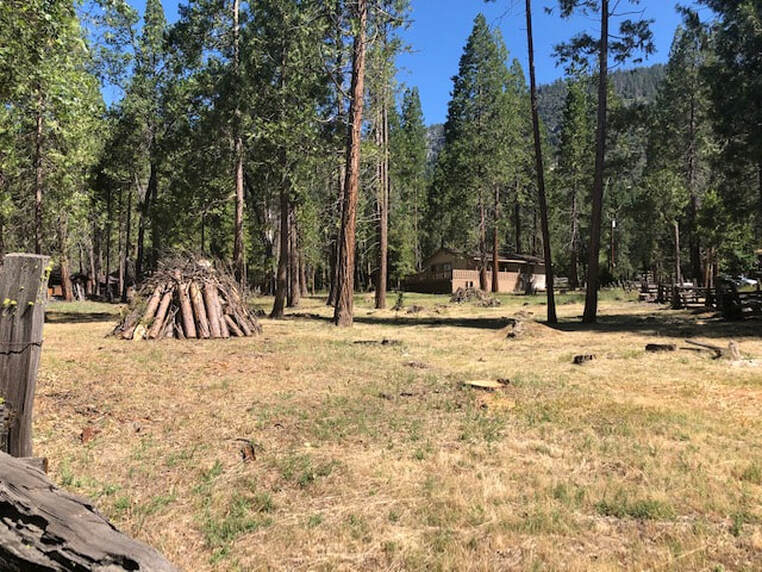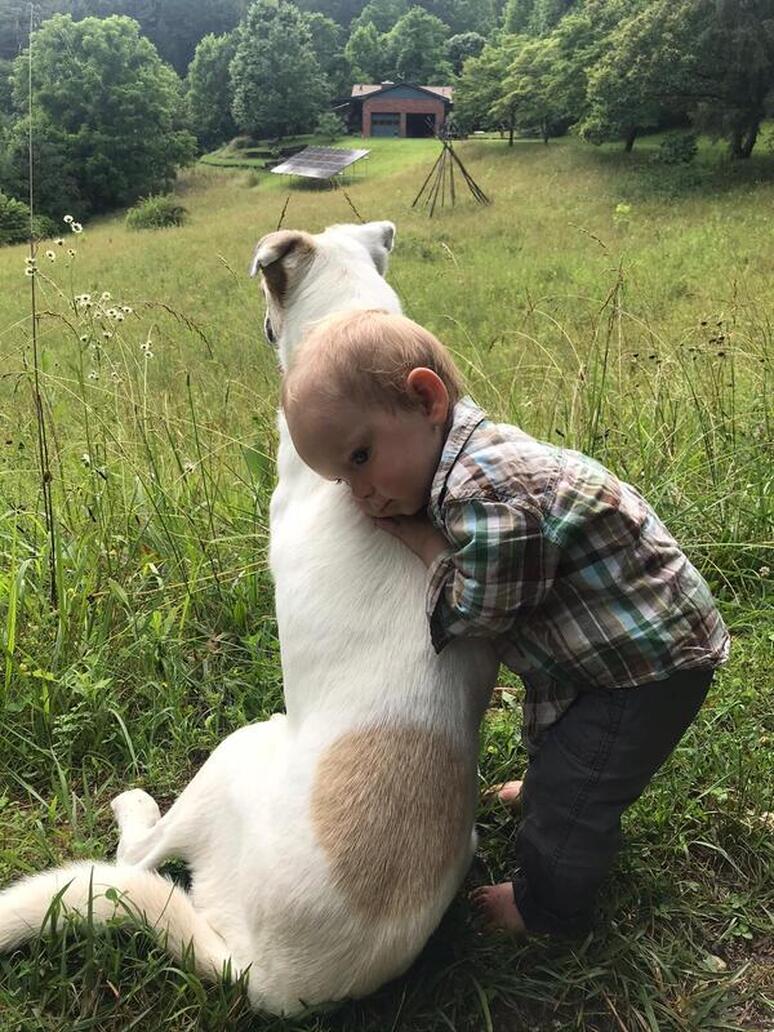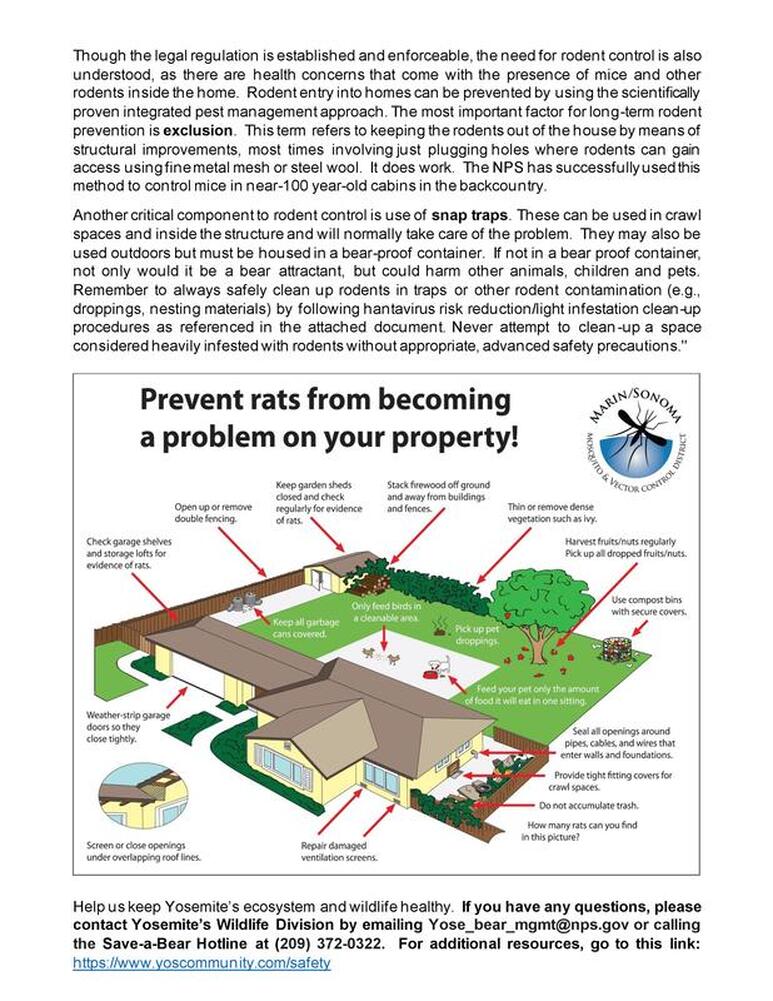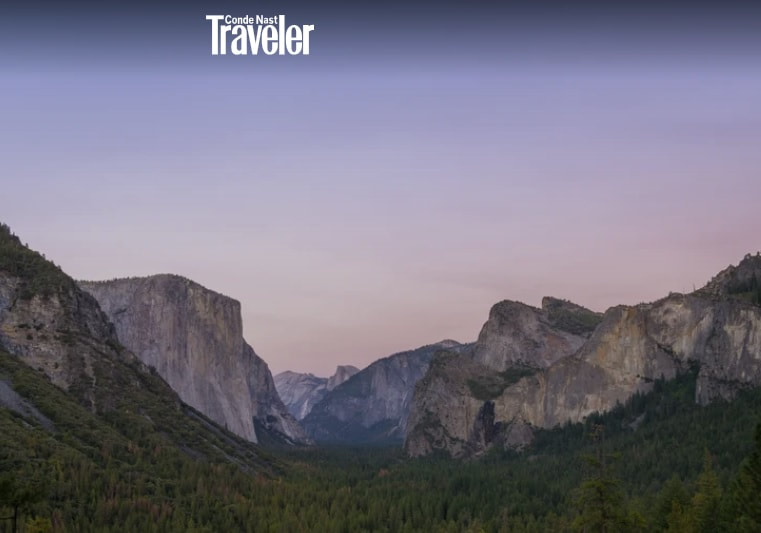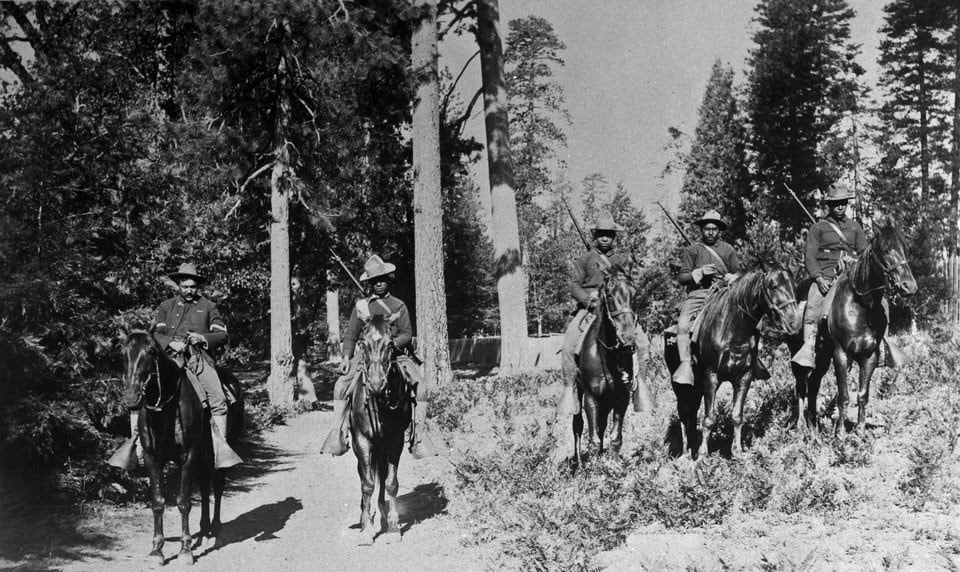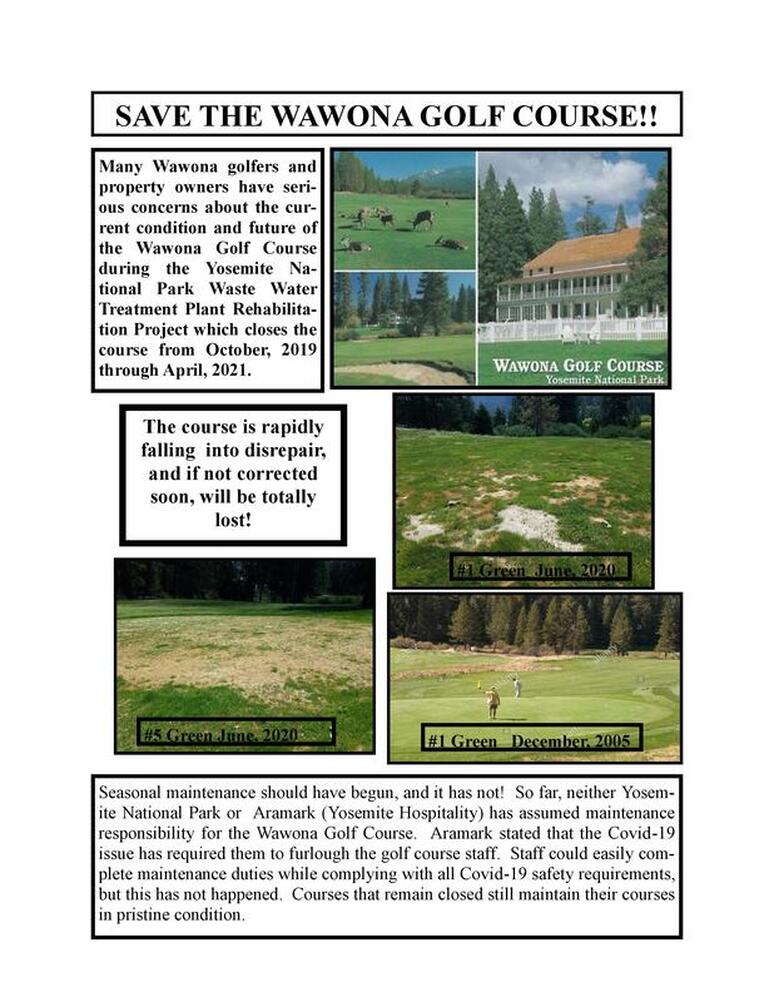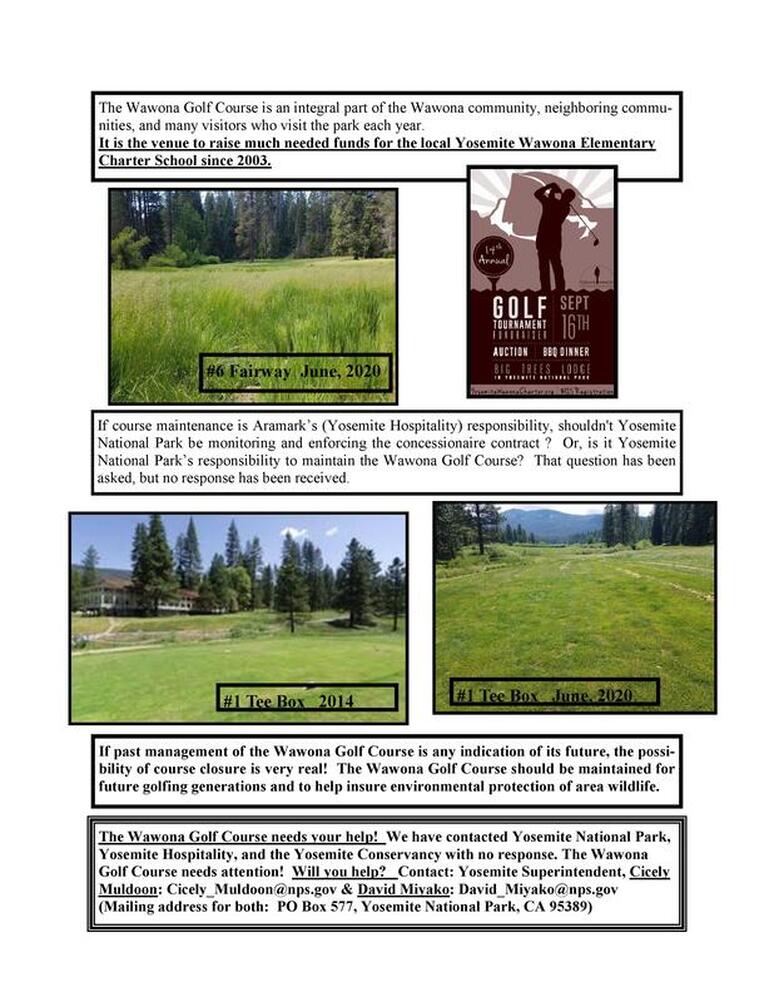WawonaNews.com - July 2020
Summer Greetings From Wawona - by Tom Bopp
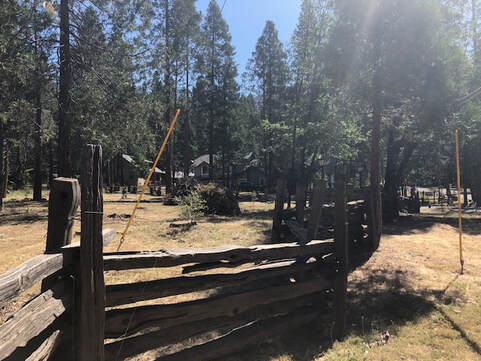
Wawona Cleanup
NPS property clean-up by Captain Parker Bevington and his engine crew at the corner of Chilnualna and East Bruce . As time allows, the crew will continue to work on tree and brush removal, and piling on NPS lands for future burning in the fall and winter.
NPS property clean-up by Captain Parker Bevington and his engine crew at the corner of Chilnualna and East Bruce . As time allows, the crew will continue to work on tree and brush removal, and piling on NPS lands for future burning in the fall and winter.
Where Are They Now?
Remember Wawona native, Landon James and his dog Una? As you can see from these "Pulitzer Prize" photos, settling nicely with Christy and James in Smoky Mountains National Park.
Remember Wawona native, Landon James and his dog Una? As you can see from these "Pulitzer Prize" photos, settling nicely with Christy and James in Smoky Mountains National Park.
CalTrans Explains How Tioga Road Is Cleared in Spring
Yosemite Leader Treats Protected Park Meadow As Golf Course, Draws Outrage
The man in charge of concession operations for Yosemite National Park had a short run in his new position after a video surfaced on social media of him teeing off at the edge of a protected meadow, aiming to strike Half Dome with a golf ball.
“That hit the rock,” said Michael Grisar at the end of a short video clip that’s since been removed but was captured by Yosemite employees and circulated widely on Thursday. Grisar was then vice president of operations for the park’s concessionaire, Yosemite Hospitality, a subsidiary of Aramark.
Aramark corporate spokesman David Freireich said Friday morning that Grisar is no longer employed by the company. He declined to comment further, saying it was a personnel matter.
The night before, Freireich shared this statement about the golf video: “We are aware of the video and have spoken with the individual, who has apologized and acknowledges using poor judgment. We have great respect for Yosemite National Park and expect all of our employees to uphold the rules and regulations that are in place to preserve and protect it.”
A Linkedin page showed Grisar served in his Yosemite position since March, and was previously vice president of operations for Wyndham Destinations in the Southwest and Mexico.
Yosemite National Park spokesman Scott Gediman said hitting golf balls into a park meadow is a hazard and littering, and that Grisar could be cited for it.
“The employee involved in the incident has apologized to the park, and we are confident that something like this will not happen again,” Gediman said Thursday night. “However, we need to be crystal clear that this type of activity is prohibited and violates park rules and regulations. Yosemite National Park is a sacred place and its care and stewardship is the responsibility of all park employees and visitors.”
Grisar did not respond to an email requesting comment for this story.
Yosemite Valley meadows are vulnerable ecosystems in the popular park that had more than 4.5 million visitors last year. Signs are posted telling visitors to stay on designated trails and not to trample through them.
The meadow Grisar was seen hitting a golf ball into is the Ahwahnee Meadow, the meadow closest to The Ahwahnee hotel. The video shows him at the edge of the meadow apparently in front of a row of employee houses that border it, with coveted views of Half Dome and Yosemite Valley, normally reserved for management and longtime employees.
It’s unclear how long Grisar will be allowed to live in Yosemite housing now that he is no longer employed by Aramark.
A number of Yosemite employees shared their concerns Thursday about the new vice president of operations, with some calling for Grisar’s resignation.
“Anyone who has lived in Yosemite is no stranger to seeing tourists trample through the meadows, feed wildlife, and leave trash behind,” said one Yosemite employee, who asked to be anonymous for fear of retribution. “As a community we all hold each other accountable if someone does not follow the leave-no-trace principle.
“If the VP of Operations was to have retrieved the golf ball after the video was taken, he would have crushed very sensitive plant life which is a common diet of the deer in Yosemite Valley. The path left would have potentially encouraged a domino effect of others to try walking through the meadow, as well. As a park we have zero tolerance for littering or destruction of nature and it is incredibly infuriating to have someone so high up feel no responsibility to help care for this land.”
“That hit the rock,” said Michael Grisar at the end of a short video clip that’s since been removed but was captured by Yosemite employees and circulated widely on Thursday. Grisar was then vice president of operations for the park’s concessionaire, Yosemite Hospitality, a subsidiary of Aramark.
Aramark corporate spokesman David Freireich said Friday morning that Grisar is no longer employed by the company. He declined to comment further, saying it was a personnel matter.
The night before, Freireich shared this statement about the golf video: “We are aware of the video and have spoken with the individual, who has apologized and acknowledges using poor judgment. We have great respect for Yosemite National Park and expect all of our employees to uphold the rules and regulations that are in place to preserve and protect it.”
A Linkedin page showed Grisar served in his Yosemite position since March, and was previously vice president of operations for Wyndham Destinations in the Southwest and Mexico.
Yosemite National Park spokesman Scott Gediman said hitting golf balls into a park meadow is a hazard and littering, and that Grisar could be cited for it.
“The employee involved in the incident has apologized to the park, and we are confident that something like this will not happen again,” Gediman said Thursday night. “However, we need to be crystal clear that this type of activity is prohibited and violates park rules and regulations. Yosemite National Park is a sacred place and its care and stewardship is the responsibility of all park employees and visitors.”
Grisar did not respond to an email requesting comment for this story.
Yosemite Valley meadows are vulnerable ecosystems in the popular park that had more than 4.5 million visitors last year. Signs are posted telling visitors to stay on designated trails and not to trample through them.
The meadow Grisar was seen hitting a golf ball into is the Ahwahnee Meadow, the meadow closest to The Ahwahnee hotel. The video shows him at the edge of the meadow apparently in front of a row of employee houses that border it, with coveted views of Half Dome and Yosemite Valley, normally reserved for management and longtime employees.
It’s unclear how long Grisar will be allowed to live in Yosemite housing now that he is no longer employed by Aramark.
A number of Yosemite employees shared their concerns Thursday about the new vice president of operations, with some calling for Grisar’s resignation.
“Anyone who has lived in Yosemite is no stranger to seeing tourists trample through the meadows, feed wildlife, and leave trash behind,” said one Yosemite employee, who asked to be anonymous for fear of retribution. “As a community we all hold each other accountable if someone does not follow the leave-no-trace principle.
“If the VP of Operations was to have retrieved the golf ball after the video was taken, he would have crushed very sensitive plant life which is a common diet of the deer in Yosemite Valley. The path left would have potentially encouraged a domino effect of others to try walking through the meadow, as well. As a park we have zero tolerance for littering or destruction of nature and it is incredibly infuriating to have someone so high up feel no responsibility to help care for this land.”
Secrets of Wawona - by Tom Bopp

YOSEMITE-WAWONA ELEMENTARY CHARTER SCHOOL
Board of Directors Regular Meeting
Tuesday, June 23, 2020
5:30 P.M.
Wawona Elementary School
7925 Chilnualana Falls Road
Wawona, CA
An On-line Meeting through Zoom
https://csustan.zoom.us/j/95555364664
CALL TO ORDER
ROLL CALL
MONTHLY ITEMS AND FINANCIAL REPORTS
CONSENT AGENDA
NOTE: The Board will be asked to approve all of the following items by a single vote, unless any member of the Board or of the public asks that an item be removed from the consent agenda and considered and discussed separately.
3.1- Approval of Agenda
3.2– Approval of Minutes of the regular meeting of May 12, 2020
3.3–Approve Payroll
3.4- Approve Warrants
3.5 -Accept Donations to YWECS
HEARING OF PERSONS WISHING TO ADDRESS THE BOARD
The public may address the Board on any matter pertaining to the school that is not on the agenda. There will be no Board discussion and no action will be taken unless listed on a subsequent agenda. Speakers will be limited to 3 minutes.
ACTION ITEMS
ADOPTION OF 2020-21 BUDGET FOR YWECS
PUBLIC HEARING OF 2020-21 BUDGET
Consideration and Action on the Adoption of the 2020-21 budget for YWECS.
ADOPTION OF THE COVID-19 OPERATIONS WRITTEN REPORT
PUBLIC HEARING ON COVID-19 OPERATIONS REPORT
Consideration and Action on the COVID-19 Operations Report that details the school’s actions in regard to the COVID-19 school closures.
ADOPTION OF A RE-OPENING PLAN FOR YWECS FOR THE 2020-21 SCHOOL YEAR
Consideration and Action on a re-opening plan detailing the procedures and protocols that will be put into place for the eventual re-opening of YWECS.
INFORMATION ITEMS
STAFF REPORTS
Student Enrollment for 2020-21
BOARD MEMBER COMMENTS
FUTURE AGENDA ITEMS
Request that various items be placed on the next agenda for discussion and/or action.
NEXT BOARD MEETING
Unless otherwise announced, the next regular meeting of the Board of Directors will be scheduled for Tuesday, August 11, 2020, at 5:30 p.m. at the Wawona School (possibly through Zoom)
CLOSED SESSION: Personnel/Negotiations/Litigation
Note: The Board will consider and may act upon any of the following items in closed session. Any action taken will be reported publically at the end of closed session as required by law.
Personnel (Gov. Code 54957)
RECONVENE IN OPEN SESSION: Announce Closed Session Actions
ADJOURNMENT
Board of Directors Regular Meeting
Tuesday, June 23, 2020
5:30 P.M.
Wawona Elementary School
7925 Chilnualana Falls Road
Wawona, CA
An On-line Meeting through Zoom
https://csustan.zoom.us/j/95555364664
CALL TO ORDER
ROLL CALL
MONTHLY ITEMS AND FINANCIAL REPORTS
CONSENT AGENDA
NOTE: The Board will be asked to approve all of the following items by a single vote, unless any member of the Board or of the public asks that an item be removed from the consent agenda and considered and discussed separately.
3.1- Approval of Agenda
3.2– Approval of Minutes of the regular meeting of May 12, 2020
3.3–Approve Payroll
3.4- Approve Warrants
3.5 -Accept Donations to YWECS
HEARING OF PERSONS WISHING TO ADDRESS THE BOARD
The public may address the Board on any matter pertaining to the school that is not on the agenda. There will be no Board discussion and no action will be taken unless listed on a subsequent agenda. Speakers will be limited to 3 minutes.
ACTION ITEMS
ADOPTION OF 2020-21 BUDGET FOR YWECS
PUBLIC HEARING OF 2020-21 BUDGET
Consideration and Action on the Adoption of the 2020-21 budget for YWECS.
ADOPTION OF THE COVID-19 OPERATIONS WRITTEN REPORT
PUBLIC HEARING ON COVID-19 OPERATIONS REPORT
Consideration and Action on the COVID-19 Operations Report that details the school’s actions in regard to the COVID-19 school closures.
ADOPTION OF A RE-OPENING PLAN FOR YWECS FOR THE 2020-21 SCHOOL YEAR
Consideration and Action on a re-opening plan detailing the procedures and protocols that will be put into place for the eventual re-opening of YWECS.
INFORMATION ITEMS
STAFF REPORTS
Student Enrollment for 2020-21
BOARD MEMBER COMMENTS
FUTURE AGENDA ITEMS
Request that various items be placed on the next agenda for discussion and/or action.
NEXT BOARD MEETING
Unless otherwise announced, the next regular meeting of the Board of Directors will be scheduled for Tuesday, August 11, 2020, at 5:30 p.m. at the Wawona School (possibly through Zoom)
CLOSED SESSION: Personnel/Negotiations/Litigation
Note: The Board will consider and may act upon any of the following items in closed session. Any action taken will be reported publically at the end of closed session as required by law.
Personnel (Gov. Code 54957)
RECONVENE IN OPEN SESSION: Announce Closed Session Actions
ADJOURNMENT
YOSEMITE NATIONAL PARK
How African American Soldiers Shaped the First National Parks by NNEKA M. OKONA
June 17, 2020
The Buffalo Soldiers and Charles Young were integral to Yosemite's earliest days.
Spending time in nature has always felt like a freedom—one I couldn’t fully quantify. Growing up, I would run with glee with my sisters through a marked trail in the wooded area behind my childhood home in Atlanta, the Georgia pine needles bristling past my arms, the sides of my torso, sometimes my face. Those sensations of feeling grounded have stayed with me. When I was overwhelmed, when I was sad, when I didn’t know what to do, I closed my eyes and went back to that place and those sounds: the popping of twigs underneath my feet, the crunch of granite gravel, the wisps of the Georgia red clay gathering in clouds as we ran.
Nature has long felt accessible to me, thanks to that time I spent outdoors as a child. The national park system throughout our country, however, has felt like a completely different world.
I visited my first national park, Chaco Culture National Historical Park some hours outside of Albuquerque, New Mexico, just a few years ago. Centered on the history of the Chacoan Native Americans and the pueblos where they lived, worked, prayed, and stargazed, the park and its guided tours enlivened me. My visit instilled in me a yearning to go further west and to learn more about the history of—and the people behind—other parks.
Yosemite National Park is at the top of that must-see list. It’s no wonder: Yosemite’s rugged mountains and canyons, shaped by wind, rain, ice, and time, draw an average of 4.4 million visitors per year, making it one of the country’s most visited national parks. But beyond imagining myself gazing at Glacier Point or feeling like a tiny speck among the colossal sequoias within Mariposa Grove, I pondered how Yosemite had come to be in the grander scheme of the park system—and whether people who looked like me, African Americans, were integral to its founding.
Nature has long felt accessible to me, thanks to that time I spent outdoors as a child. The national park system throughout our country, however, has felt like a completely different world.
I visited my first national park, Chaco Culture National Historical Park some hours outside of Albuquerque, New Mexico, just a few years ago. Centered on the history of the Chacoan Native Americans and the pueblos where they lived, worked, prayed, and stargazed, the park and its guided tours enlivened me. My visit instilled in me a yearning to go further west and to learn more about the history of—and the people behind—other parks.
Yosemite National Park is at the top of that must-see list. It’s no wonder: Yosemite’s rugged mountains and canyons, shaped by wind, rain, ice, and time, draw an average of 4.4 million visitors per year, making it one of the country’s most visited national parks. But beyond imagining myself gazing at Glacier Point or feeling like a tiny speck among the colossal sequoias within Mariposa Grove, I pondered how Yosemite had come to be in the grander scheme of the park system—and whether people who looked like me, African Americans, were integral to its founding.
“African American soldiers in 1899, 1903, and 1904 were some of the first park rangers in the world, not just in the United States,” says Shelton Johnson, a Yosemite park ranger who has committed himself to preserving and sharing the history of African American stewardship within the national parks through decades of work.
Between 1891 and 1913, the U.S. Army was the designated administrator of both Yosemite National Park and Sequoia National Park, with two troops of up to 60 men assigned to each park. Buffalo Soldiers—African American soldiers supposedly given that name because of their association to the western frontier—of both the Ninth Cavalry and 24th Infantry were included in these numbers. Racism, discrimination, bigotry, and the threat of violence were a large part of the experience of African American soldiers within the U.S. Army at this time. But for the bulk of the Buffalo Soldiers, who were veterans of either the Philippine-American or Spanish-American wars, joining these companies was a ticket toward financial security and thus became a gateway to being a guardian of the western wilderness.
“It makes sense why African Americans would join the army—because that was a path up and path out,” says Johnson. And no one took advantage of that path more than the ever industrious Charles Young. The third Black graduate of West Point University, Young became the military superintendent of Sequoia National Park in the summer of 1903.
He is widely considered to have been the first ever African American superintendent of a national park. Under his leadership, he created an infrastructure of trails, paved roads, and bridges, some of which are still in use today. In researching the ranger, Johnson also discovered Young’s friendship with W.E.B. DuBois. The two met while teaching at Wilberforce University in Ohio.
“Charles Young was not really well known, even to African Americans, even though he should have been and would have become if America had been a better country 100 years ago,” Johnson says.
Today, African Americans are still underrepresented as park rangers. A 2008-2009 National Park survey asserted that 80 percent of its approximately 22,000 employees, including park rangers, are white. Demographics of its 200,000 or so volunteers mirrors the same percentage.
And just as I had never been to a national park up until a few years ago, Johnson says that although African American solo visitors and those visiting with their families have increased in recent years, the vast majority of visitors aren’t us. The National Park Service does not regularly keep track of visitor demographics, but a 2010 study of park use found that just 1 percent of visitors to national parks were Black. (The last proper study was done in 1999 by Myron Floyd, scholar and dean of the College of Natural Resources at North Carolina State University.)
“We arrived as indigenous Africans comfortable in the outdoors,” Johnson says. “But when you’ve been enslaved for many generations and trapped and beaten or worse for having the temerity to escape… then that environment will forever be stained by what happened. [That fear] is in our genes.”
There are small caveats to all of those numbers. One is that perhaps expecting large numbers of Black visitors at parks where there are very few African Americans living nearby is wishful thinking. The other, in terms of rangers, amounts to cultural baggage and geographic comfort, according to Johnson. African American rangers are more likely to be found in urban cores like Boston or New York, or at the Tuskegee Airmen National Historic Site in Alabama, rather than more remote wilderness parks.
Considering the wealth of historical connection at both Yosemite and Sequoia—and throughout the national parks system at large—it’s both striking and painful to hold why the disconnect exists. Johnson hopes that by learning of these connections, more African Americans will reclaim their wilderness heritage.
Due to the ongoing coronavirus pandemic, my trip was postponed mere days before I was slated to head to both Yosemite and Sequoia National Parks. But that hasn’t stopped me from planning my future visit. I plan to roam where my ancestors once walked, guarded the land, and cleared the trails still walked upon today, and to gaze up through the boughs of towering sequoias for that same grounded sense I found on trails as a child. I look forward to that moment of quiet I’ve learned only nature can provide in Yosemite Valley, which Johnson refers to as “the greatest cathedral on the face of the earth.” And I hope to find validation and consolation in experiencing it all as a celebration of our mighty past—and a reclamation of the lands we have communed with from the very beginning.
Between 1891 and 1913, the U.S. Army was the designated administrator of both Yosemite National Park and Sequoia National Park, with two troops of up to 60 men assigned to each park. Buffalo Soldiers—African American soldiers supposedly given that name because of their association to the western frontier—of both the Ninth Cavalry and 24th Infantry were included in these numbers. Racism, discrimination, bigotry, and the threat of violence were a large part of the experience of African American soldiers within the U.S. Army at this time. But for the bulk of the Buffalo Soldiers, who were veterans of either the Philippine-American or Spanish-American wars, joining these companies was a ticket toward financial security and thus became a gateway to being a guardian of the western wilderness.
“It makes sense why African Americans would join the army—because that was a path up and path out,” says Johnson. And no one took advantage of that path more than the ever industrious Charles Young. The third Black graduate of West Point University, Young became the military superintendent of Sequoia National Park in the summer of 1903.
He is widely considered to have been the first ever African American superintendent of a national park. Under his leadership, he created an infrastructure of trails, paved roads, and bridges, some of which are still in use today. In researching the ranger, Johnson also discovered Young’s friendship with W.E.B. DuBois. The two met while teaching at Wilberforce University in Ohio.
“Charles Young was not really well known, even to African Americans, even though he should have been and would have become if America had been a better country 100 years ago,” Johnson says.
Today, African Americans are still underrepresented as park rangers. A 2008-2009 National Park survey asserted that 80 percent of its approximately 22,000 employees, including park rangers, are white. Demographics of its 200,000 or so volunteers mirrors the same percentage.
And just as I had never been to a national park up until a few years ago, Johnson says that although African American solo visitors and those visiting with their families have increased in recent years, the vast majority of visitors aren’t us. The National Park Service does not regularly keep track of visitor demographics, but a 2010 study of park use found that just 1 percent of visitors to national parks were Black. (The last proper study was done in 1999 by Myron Floyd, scholar and dean of the College of Natural Resources at North Carolina State University.)
“We arrived as indigenous Africans comfortable in the outdoors,” Johnson says. “But when you’ve been enslaved for many generations and trapped and beaten or worse for having the temerity to escape… then that environment will forever be stained by what happened. [That fear] is in our genes.”
There are small caveats to all of those numbers. One is that perhaps expecting large numbers of Black visitors at parks where there are very few African Americans living nearby is wishful thinking. The other, in terms of rangers, amounts to cultural baggage and geographic comfort, according to Johnson. African American rangers are more likely to be found in urban cores like Boston or New York, or at the Tuskegee Airmen National Historic Site in Alabama, rather than more remote wilderness parks.
Considering the wealth of historical connection at both Yosemite and Sequoia—and throughout the national parks system at large—it’s both striking and painful to hold why the disconnect exists. Johnson hopes that by learning of these connections, more African Americans will reclaim their wilderness heritage.
Due to the ongoing coronavirus pandemic, my trip was postponed mere days before I was slated to head to both Yosemite and Sequoia National Parks. But that hasn’t stopped me from planning my future visit. I plan to roam where my ancestors once walked, guarded the land, and cleared the trails still walked upon today, and to gaze up through the boughs of towering sequoias for that same grounded sense I found on trails as a child. I look forward to that moment of quiet I’ve learned only nature can provide in Yosemite Valley, which Johnson refers to as “the greatest cathedral on the face of the earth.” And I hope to find validation and consolation in experiencing it all as a celebration of our mighty past—and a reclamation of the lands we have communed with from the very beginning.
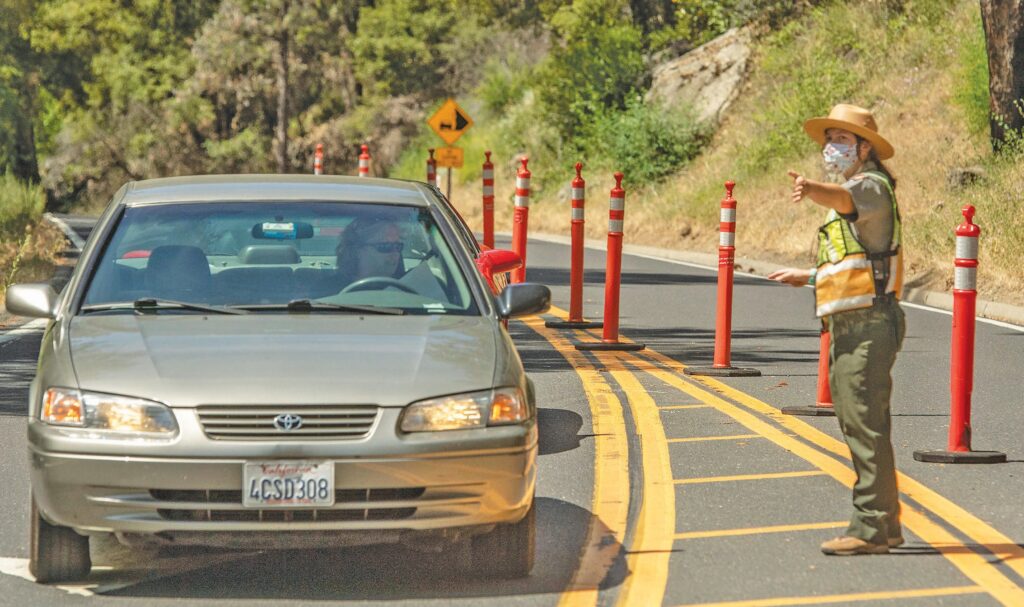 Rebecca Lund, the National Park Service Supervisor at the Arch Rock Entrance, directs a driver last Thursday, the first day Yosemite National Park opened for visitors. Photo by Al Golub/National Park Service
Rebecca Lund, the National Park Service Supervisor at the Arch Rock Entrance, directs a driver last Thursday, the first day Yosemite National Park opened for visitors. Photo by Al Golub/National Park Service
Yosemite Reopens To Tourists, Officials Pleased With Program
Mariposa Gazette - June 18, 2020
By GREG LITTLE Editor
So far, so good.
That was the word Monday from Yosemite National Park after it opened last week on a limited basis.
“Everything went real well,” said Scott Gediman of the media relations office at Yosemite.
The park reopened last Thursday after being closed for three months because of the Covid-19 pandemic. But the reopening has created a different look for Yosemite during the height of the tourist season.
Park officials are limiting the number of vehicles allowed in the park as people have to purchase a pass to get inside.
“The visitors are being wonderful,” said Gediman. “Obviously, the word got out about the reservation system.”
Gediman said fewer than 10 people had to be turned away because they did not have the required pass to get inside.
He reported that at the entrance stations, the public was “cooperative,” and said people in Yosemite Valley have “been really good.”
The reopening of the park came following a lot of discussions and meetings which included officials from Mariposa County, including Dr. Eric Sergienko, the county health officer.
“We’re so appreciative of the county,” said Gediman. “Dr. Sergienko has been wonderful. That laid the groundwork for so much. We did all of the planning and I feel it is paying dividends right now.”
He said the opening was a “regional effort” with various agencies from all the counties around the park giving input.
“From a public health perspective, everybody has been real supportive,” said Gediman. “I feel that the regional approach has really helped with the success of our initial launch.”
Balancing act
The opening of the park with limited visitation has drawn the ire of some, including those who think park officials are not letting enough people in to those who believe too many people are being drawn to this area in the midst of a pandemic.
“To me, I think it is a wonderful balance,” said Gediman.
Gediman said he was “out a bit” on Monday and said the visitors “are doing whey they are always doing.”
That includes visiting the waterfalls, fishing at the river and many other activities. He called it “back to normal,” at least the new normal of limited visitation.
“People are not crowding,” said Gediman.
With fewer people, Gediman said there are a lot less visitors at spots like Tunnel View and Yosemite Falls.
“People are being respectful of each other and respectful of the park,” said Gediman.
Gediman said park officials are closely monitoring the situation and in the coming days, they will be “coming up” with reports based on observations. That can include the number of people at certain locations and much more, he said.
“We feel really good,” said Gediman.
From the perspective of park officials, Gediman said the normal “challenges” faced at Yosemite are not happening this year. Those include parking woes, traffic jams, overcrowding at sites and more.
For example, Gediman said the popular Mist Trail is now one-way and people are complying. “That seems to be going well,” he said.
Manageable situation
Gediman said this past Saturday, like most weekends, “was busier, but again, manageable.”
He said some of the concerns before the opening, like parking and having no valley shuttle buses, seem to be working out. Gediman also said without long lines at many of the attractions, it seems to be working, including people finding places to park.
“For now, it is working real well,” said Gediman.
He said officials are discussing the current program which allows a certain number of people in the park and whether to adjust that number, but “no decisions” have been made.
“We’re not even a week into it, but this is exactly what we had hoped to accomplish,” said Gediman. “We’ve established a reasonable number and we know what to expect. It has been nice.”
It hasn’t hurt the weather has been nice, he said.
“The weather has been wonderful. The park looks great. The meadows are green. The waterfalls …,” he said.
One issue that arose prior to the opening of the park was just how many more animals were being seen by those living at the park as well as the various delivery people who kept the park supplied.
“I haven’t seen a huge change,” said Gediman. “Bears are active, but they are always active this time of year.”
Gediman said, like always, “the animals are adaptable. They were adaptable before and now there are more people. The bears are out and they are hungry.”
Keep on keeping on
Gediman also said Aramark, the park concessionaire, is working to “provide a safe environment.” (See related story about Aramark.)
“We want to provide the most diverse, complete experience possible,” said Gediman.
In doing that, Gediman said he feels good about the fact so much has opened in Yosemite as compared to other national parks around the country.
“We’ve opened a lot,” he said.
That includes restaurants, stores, campgrounds, hotels, the visitors center and more.
Gediman also said the pass system has worked well so far. Anyone wanting a pass can do so online and Gediman said people “can get passes fairly readily.”
There are likely many factors involved in that, including there are no foreign travelers coming to Yosemite as well as the fact many people in California — and across the country — are limiting travel.
All of that does have an impact on one group of people and that is those who live in the park. Those include park workers, concessionaire workers, spouses of workers and more.
“Everyone is feeling good,” said Gediman. “There was certainly some apprehension, but so far, everyone is good.”
Gediman said having the reservation system means “there are fewer people here” and the local people, too, are “not seeing the crowding. Not only is it a calmer environment, but people are saying it is nice because the visitors are acting responsibly.”
Over the past week or so, many areas of the park have reopened as they normally do this time of year. That includes Glacier Point, Tioga Road and Hetch Hetchy.
One place that also opened is the Mariposa Grove of Giant Sequoias, which underwent a major reconstruction two years ago and is one of the most popular spots in Yosemite.
But this year, the shuttle system to the grove is not operating and that means visitors have to take a long hike up the road just to get to the grove. Then, there is a long walk inside the grove and the return trip.
People who have a handicapped plaque on their car can drive to the grove area, but nobody else, said Gediman.
Gediman said he does have concerns about people having to walk that far to see the Mariposa Grove, but for this year, that is the program which is in place.
Mariposa Gazette - June 18, 2020
By GREG LITTLE Editor
So far, so good.
That was the word Monday from Yosemite National Park after it opened last week on a limited basis.
“Everything went real well,” said Scott Gediman of the media relations office at Yosemite.
The park reopened last Thursday after being closed for three months because of the Covid-19 pandemic. But the reopening has created a different look for Yosemite during the height of the tourist season.
Park officials are limiting the number of vehicles allowed in the park as people have to purchase a pass to get inside.
“The visitors are being wonderful,” said Gediman. “Obviously, the word got out about the reservation system.”
Gediman said fewer than 10 people had to be turned away because they did not have the required pass to get inside.
He reported that at the entrance stations, the public was “cooperative,” and said people in Yosemite Valley have “been really good.”
The reopening of the park came following a lot of discussions and meetings which included officials from Mariposa County, including Dr. Eric Sergienko, the county health officer.
“We’re so appreciative of the county,” said Gediman. “Dr. Sergienko has been wonderful. That laid the groundwork for so much. We did all of the planning and I feel it is paying dividends right now.”
He said the opening was a “regional effort” with various agencies from all the counties around the park giving input.
“From a public health perspective, everybody has been real supportive,” said Gediman. “I feel that the regional approach has really helped with the success of our initial launch.”
Balancing act
The opening of the park with limited visitation has drawn the ire of some, including those who think park officials are not letting enough people in to those who believe too many people are being drawn to this area in the midst of a pandemic.
“To me, I think it is a wonderful balance,” said Gediman.
Gediman said he was “out a bit” on Monday and said the visitors “are doing whey they are always doing.”
That includes visiting the waterfalls, fishing at the river and many other activities. He called it “back to normal,” at least the new normal of limited visitation.
“People are not crowding,” said Gediman.
With fewer people, Gediman said there are a lot less visitors at spots like Tunnel View and Yosemite Falls.
“People are being respectful of each other and respectful of the park,” said Gediman.
Gediman said park officials are closely monitoring the situation and in the coming days, they will be “coming up” with reports based on observations. That can include the number of people at certain locations and much more, he said.
“We feel really good,” said Gediman.
From the perspective of park officials, Gediman said the normal “challenges” faced at Yosemite are not happening this year. Those include parking woes, traffic jams, overcrowding at sites and more.
For example, Gediman said the popular Mist Trail is now one-way and people are complying. “That seems to be going well,” he said.
Manageable situation
Gediman said this past Saturday, like most weekends, “was busier, but again, manageable.”
He said some of the concerns before the opening, like parking and having no valley shuttle buses, seem to be working out. Gediman also said without long lines at many of the attractions, it seems to be working, including people finding places to park.
“For now, it is working real well,” said Gediman.
He said officials are discussing the current program which allows a certain number of people in the park and whether to adjust that number, but “no decisions” have been made.
“We’re not even a week into it, but this is exactly what we had hoped to accomplish,” said Gediman. “We’ve established a reasonable number and we know what to expect. It has been nice.”
It hasn’t hurt the weather has been nice, he said.
“The weather has been wonderful. The park looks great. The meadows are green. The waterfalls …,” he said.
One issue that arose prior to the opening of the park was just how many more animals were being seen by those living at the park as well as the various delivery people who kept the park supplied.
“I haven’t seen a huge change,” said Gediman. “Bears are active, but they are always active this time of year.”
Gediman said, like always, “the animals are adaptable. They were adaptable before and now there are more people. The bears are out and they are hungry.”
Keep on keeping on
Gediman also said Aramark, the park concessionaire, is working to “provide a safe environment.” (See related story about Aramark.)
“We want to provide the most diverse, complete experience possible,” said Gediman.
In doing that, Gediman said he feels good about the fact so much has opened in Yosemite as compared to other national parks around the country.
“We’ve opened a lot,” he said.
That includes restaurants, stores, campgrounds, hotels, the visitors center and more.
Gediman also said the pass system has worked well so far. Anyone wanting a pass can do so online and Gediman said people “can get passes fairly readily.”
There are likely many factors involved in that, including there are no foreign travelers coming to Yosemite as well as the fact many people in California — and across the country — are limiting travel.
All of that does have an impact on one group of people and that is those who live in the park. Those include park workers, concessionaire workers, spouses of workers and more.
“Everyone is feeling good,” said Gediman. “There was certainly some apprehension, but so far, everyone is good.”
Gediman said having the reservation system means “there are fewer people here” and the local people, too, are “not seeing the crowding. Not only is it a calmer environment, but people are saying it is nice because the visitors are acting responsibly.”
Over the past week or so, many areas of the park have reopened as they normally do this time of year. That includes Glacier Point, Tioga Road and Hetch Hetchy.
One place that also opened is the Mariposa Grove of Giant Sequoias, which underwent a major reconstruction two years ago and is one of the most popular spots in Yosemite.
But this year, the shuttle system to the grove is not operating and that means visitors have to take a long hike up the road just to get to the grove. Then, there is a long walk inside the grove and the return trip.
People who have a handicapped plaque on their car can drive to the grove area, but nobody else, said Gediman.
Gediman said he does have concerns about people having to walk that far to see the Mariposa Grove, but for this year, that is the program which is in place.
Entrance Reservations
Based on local, state, and federal public health guidelines, the number of vehicles entering Yosemite must be reduced from normal visitation levels for public safety. This helps reduce overcrowding at the park’s most popular destinations. The park is aiming to increase public access while providing visitors with a reasonable opportunity to comply with health guidelines. The day-use reservation system is a temporary system that has been created to address public health concerns resulting from the COVID-19 pandemic.
The day-use reservations only limits the number of vehicles; it does not limit the number of people.
The day-use reservations only limits the number of vehicles; it does not limit the number of people.
Day-Use Reservation
Day-use reservations are only available via recreation.gov. Reservations will go quickly; be sure to be logged in and ready to get a reservation promptly at 7 am Pacific time.
The reservation fee is $2 and is included in the $35/car park entrance fee. If you have an annual or lifetime pass, be sure to specify you're a current pass holder to pay just the $2 fee.
Beginning at 7 am Pacific time on the first of each month, 80% of day-use reservations are available for the following month. For example, on July 1 at 7 am, day-use reservations for all dates in August will be available.
Beginning at 7 am Pacific time two days ahead of the day-use reservation date, the remaining 20% of day-use reservations will be available. For example, on July 1 at 7 am, day-use reservations for July 3 will be available.
Cancelled reservations become available immediately on recreation.gov.
Each user can make one reservation per day. Only one reservation is needed per vehicle (regardless of the number of people in the vehicle).
Day-use permits are valid for seven consecutive days for unlimited entries. Day-use permits are not valid for overnight use (the park is only open to day-use permit holders from 5 am to 11 pm).
In-Park Camping, Lodging, or Vacation Rentals
If you have a reservation for one of the following, you do not need an additional reservation. You still pay the $35/car entrance fee upon arrival (credit card only) unless you have an annual or lifetime pass.The overnight vehicle permit you receive will be valid for seven consecutive days for unlimited entries.
Wilderness or Half Dome Permits
If you have a wilderness permit reservation (for backpacking) or Half Dome permit, you do not need an additional reservation or permit. You still pay the $35/car entrance fee upon arrival (credit card only) unless you have an annual or lifetime pass. The overnight vehicle permit you receive will be valid for seven consecutive days for unlimited entries.
Please note that a Half Dome permit only provides day-use access to Yosemite (5 am to 11 pm). Overnight accommodations are not available unless you have reserved them separately. A Half Dome permit does not allow you to camp in Yosemite.
Regional Transit or Tour GroupsIf you have a reservation for Yosemite Area Regional Transporation System (YARTS) or with an authorized tour group, you do not need an additional reservation or permit.
Still have questions?We have answers!
Day-use reservations are only available via recreation.gov. Reservations will go quickly; be sure to be logged in and ready to get a reservation promptly at 7 am Pacific time.
The reservation fee is $2 and is included in the $35/car park entrance fee. If you have an annual or lifetime pass, be sure to specify you're a current pass holder to pay just the $2 fee.
Beginning at 7 am Pacific time on the first of each month, 80% of day-use reservations are available for the following month. For example, on July 1 at 7 am, day-use reservations for all dates in August will be available.
Beginning at 7 am Pacific time two days ahead of the day-use reservation date, the remaining 20% of day-use reservations will be available. For example, on July 1 at 7 am, day-use reservations for July 3 will be available.
Cancelled reservations become available immediately on recreation.gov.
Each user can make one reservation per day. Only one reservation is needed per vehicle (regardless of the number of people in the vehicle).
Day-use permits are valid for seven consecutive days for unlimited entries. Day-use permits are not valid for overnight use (the park is only open to day-use permit holders from 5 am to 11 pm).
In-Park Camping, Lodging, or Vacation Rentals
If you have a reservation for one of the following, you do not need an additional reservation. You still pay the $35/car entrance fee upon arrival (credit card only) unless you have an annual or lifetime pass.The overnight vehicle permit you receive will be valid for seven consecutive days for unlimited entries.
- Upper Pines Campground or Wawona Horse Camp reservation
- Yosemite Valley Lodge, Curry Village, or The Ahwahnee reservation
- Private lodging or vacation rental reservation in Wawona, Yosemite West, or Foresta
Reservations for lodging or vacation rentals outside the park and in communities other than these three do not provide access to Yosemite.
Wilderness or Half Dome Permits
If you have a wilderness permit reservation (for backpacking) or Half Dome permit, you do not need an additional reservation or permit. You still pay the $35/car entrance fee upon arrival (credit card only) unless you have an annual or lifetime pass. The overnight vehicle permit you receive will be valid for seven consecutive days for unlimited entries.
Please note that a Half Dome permit only provides day-use access to Yosemite (5 am to 11 pm). Overnight accommodations are not available unless you have reserved them separately. A Half Dome permit does not allow you to camp in Yosemite.
Regional Transit or Tour GroupsIf you have a reservation for Yosemite Area Regional Transporation System (YARTS) or with an authorized tour group, you do not need an additional reservation or permit.
Still have questions?We have answers!
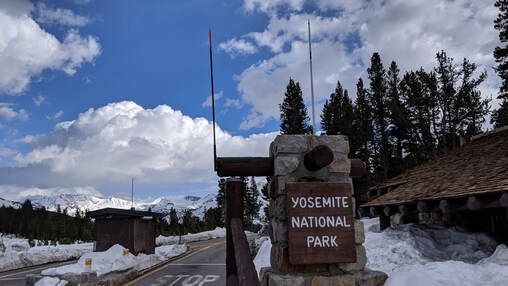
Tioga Road Opening
Tioga Road will open on Monday, June 15 at 9 am. A reservation is required to enter the park and use Tioga Road.
Bicycles will be allowed beginning Saturday, June 13. (A reservation is required if entering the park by car to then cycle on the road. A reservation is not required to cycle into the park.)
Tioga Road will open on Monday, June 15 at 9 am. A reservation is required to enter the park and use Tioga Road.
Bicycles will be allowed beginning Saturday, June 13. (A reservation is required if entering the park by car to then cycle on the road. A reservation is not required to cycle into the park.)
